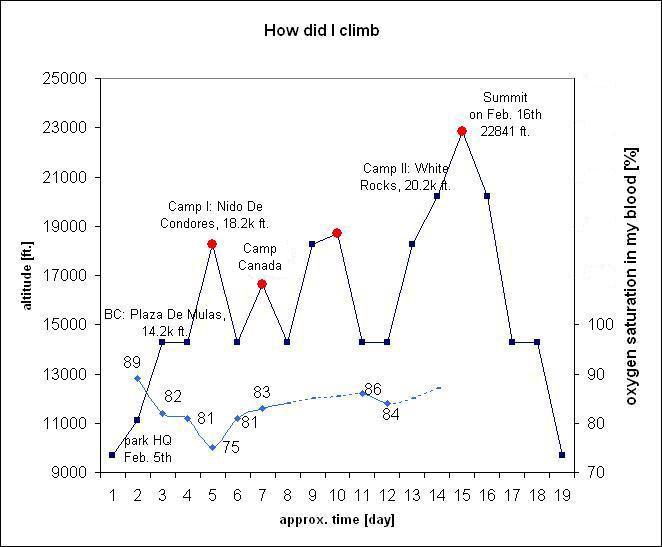On Feb 5th, we had gas, food, permits, and everything packed for the mules. For easier acclimatization, we took two days to reach Base Camp Plaza de Mulas (referred further as the BC) with an extra night spent at Confluencia camp (3390m). After one day of rest at the BC (4350m), we started our siege by setting up advanced camps. The first stage of our plan was to get tents, gas, and food deposits to Nido de Condores camp. It was our Camp One. When that was done, we came back to the BC and followed it by another day of rest. After that, the plan was to sleep at Nido and the next day put gas/food deposits above Camp Berlin, our Camp Two. From there, in the next several days, we would start our summit bid.
For me, it was a crisis day. It became painfully apparent that I was not acclimating as fast as the rest of the group. My oxygen saturation was dropping to 75% leaving me with headaches and a lack of strength. After only reaching Camp Canada (5050m), I had to retreat back to the BC, but the rest of our group was proceeding according to the action plan set by our leader Boguslaw Magrel. The next day, I joined the rest of the group at Nido and spent one night there. The following day, I gained another 300m and I went back down to the BC for last rest day.
To my delight, my vital signs were improving. The oxygen saturation of my blood was going up to whopping 86%. On Feb. 14th, we started our final ascent. We rested at Camp One and the next day moved our tents to Camp Two, White Rocks above Berlin (approx. 6200m). At this point, it is important to mention the weather ramifications we were facing at the time. Over last several days there was a snowstorm coming over the mountain every day. Only early mornings looked calm and free of clouds. The weather forecast was calling for one day free of storms and we wanted to align it with our summit day. To take advantage of that early morning good weather pattern, we wanted to start early.
At 2:30 am on Feb. 16th, we were boiling water, eating breakfast, and putting on our battle gear, out of which chemical warmers were a very important part. The temperature outside our tent was close to -30 C with noticeable wind. At around 3:50 am, we started our summit bid. Progress was steady, but above Independencia Shelter (6370m), the wind became much stronger. It was instantaneously covering any previous tracks. Coldness, darkness, fluffy, waist deep snow, and the very steep slope seemed to complete the recipe for disaster . These dreadful conditions divided our group. Five from the group decided to go back. The rest of us consolidated our efforts and began to share the task of breaking trail.
The progress was slow because of extreme danger of triggering an avalanche. I do not know how much time it took us to steer clear from that slope but it was close to sunrise and at that point we were still far from the so-called Canaleta. How do I know it was close to sunrise? On the horizon to the West, I saw a huge, triangular shadow of the mountain reminding me about our goal for that day. From that point, due to lack of oxygen and low pressure, the climb was increasingly difficult, but strong wind stopped.
At around 11am, the small group I was with reached the summit. The weather was just perfect, warm, and calm, with incredible visibility as if through our hard work we earned it from the Guard of Stone. I felt great, no headache, and no other signs of altitude problems.
After a 30 minutes break, we started our way down. Shortly after that, when passing a climber going up, a chunk of snow gave up and I was about to slide down the slope. Fortunately, the self-arresting reflex stopped my slide. After short three hours, I was in my tent in Camp Two. I started melting snow and making tea for my coming down friends and my self. I stayed in that place for another night. My tent mate Hubert and one other person, (they were in the group of five turning back that day) decided to try the next day and made to the top.
After a quite restful night, I reached Nido in one and a half hour with extra gear on my back. Because one of us had very severe frostbite from last day climb, we all had to help him get back to the BC. It became obvious that sneakers would not work; in fact, his plastic boots were not working neither. When reaching Nido more bad news was "waiting" for me. Park rangers were looking for two climbers. I had no idea who these people were; neither had I seen anybody lost along my way down. After picking up trash at Nido and two more hours, I went all the way down to the BC. I was happy that I made it safe, but saddened by all these unfortunate consequences of bad weather.
P.S.: Lost climbers found their way back to Nido after two nights spent without food and shelter.

Webmaster Aaron Schuman inquires:
> I wish you had mentioned was how you measured oxygen saturation.
Andrew Wirkus replies:
In the Base Camp there was a doctor on duty for 8h every day. She had a simple looking measuring device. It was a clip she was putting on middle finger of her patients. Dotted line on my graph is extrapolation/interpolation; solid line represents data from the days I went to see the doctor.
On 16th, we reached the summit. The next night I spent at Camp II (White Rocks) then two nights at BC. On 19th, at around 6pm, we were back at Park HQ.